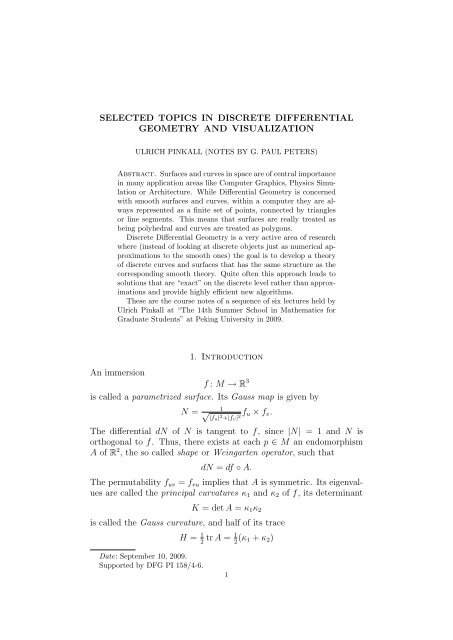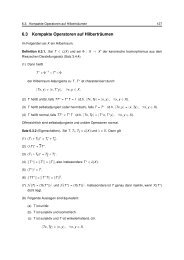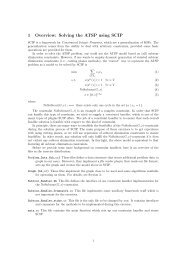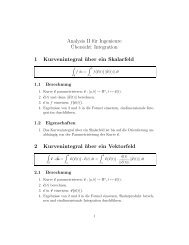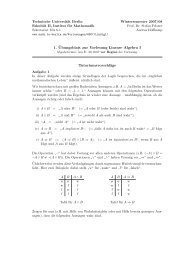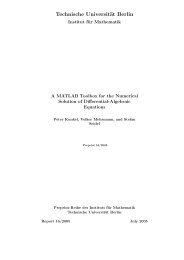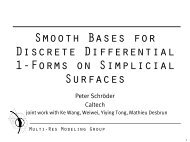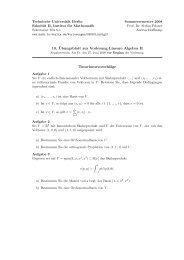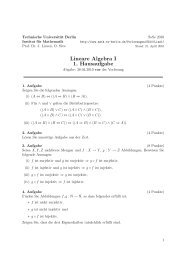Lecture notes - Institut für Mathematik - TU Berlin
Lecture notes - Institut für Mathematik - TU Berlin
Lecture notes - Institut für Mathematik - TU Berlin
Create successful ePaper yourself
Turn your PDF publications into a flip-book with our unique Google optimized e-Paper software.
SELECTED TOPICS IN DISCRETE DIFFERENTIALGEOMETRY AND VISUALIZATIONULRICH PINKALL (NOTES BY G. PAUL PETERS)Abstract. Surfaces and curves in space are of central importancein many application areas like Computer Graphics, Physics Simulationor Architecture. While Differential Geometry is concernedwith smooth surfaces and curves, within a computer they are alwaysrepresented as a finite set of points, connected by trianglesor line segments. This means that surfaces are really treated asbeing polyhedral and curves are treated as polygons.Discrete Differential Geometry is a very active area of researchwhere (instead of looking at discrete objects just as numerical approximationsto the smooth ones) the goal is to develop a theoryof discrete curves and surfaces that has the same structure as thecorresponding smooth theory. Quite often this approach leads tosolutions that are “exact” on the discrete level rather than approximationsand provide highly efficient new algorithms.These are the course <strong>notes</strong> of a sequence of six lectures held byUlrich Pinkall at “The 14th Summer School in Mathematics forGraduate Students” at Peking University in 2009.1. IntroductionAn immersionf : M → R 3is called a parametrized surface. Its Gauss map is given byN =1√|f u| 2 +|f v| 2 f u × f v .The differential dN of N is tangent to f, since |N| = 1 and N isorthogonal to f. Thus, there exists at each p ∈ M an endomorphismA of R 2 , the so called shape or Weingarten operator, such thatdN = df ◦ A.The permutability f uv = f vu implies that A is symmetric. Its eigenvaluesare called the principal curvatures κ 1 and κ 2 of f, its determinantK = det A = κ 1 κ 2is called the Gauss curvature, and half of its traceH = 1 2 tr A = 1 2 (κ 1 + κ 2 )Date: September 10, 2009.Supported by DFG PI 158/4-6.1
TOPICS IN DISCRETE DIFFERENTIAL GEOMETRY AND VISUALIZATION 3where m de<strong>notes</strong> the mass and k the spring constant. In the continuumlimitklimɛ→0 m ɛ2 = c, c ∈ Rthus ˜f tt = ˜f xx .˜f x (x − ɛ , t) = − lim2 ɛ→0˜f x (x + ɛ , t) = lim2 ɛ→0˜f(n − 1, t) − ˜f(n, t), andɛ˜f(n + 1, t) − ˜f(n, t),ɛ2.6. Discrete wave equation. The discrete wave equation is thepiecewise linear case of the continuous wave equation. Consider asin Lemma 2.4f(u, v) = ϕ(u) + ψ(v),with piecewise linear ϕ and ψ, i.e., linear on intervals [n, n + 1], n ∈Z. Hence ϕ and ψ are completely determined by their values on theintegers Z and f solves the discrete wave equationf(n, m) + f(n + 1, m + 1) = f(n + 1, m) + f(n, m + 1),n, m ∈ Z. The piecewise linear map f maps fundamental squaresof the integer lattice Z × Z onto parallelograms. Since three verticesof a parallelogram determine the fourth vertex, f is determined by itsvalues at time zero and time one, i.e., by f(n, n) and f(n+1, n), n ∈ Z.These values thus constitute some Cauchy initial data for the discretewave equation a so called initial zigzag.2.7. Project. Implement the discrete wave equation so that the movementof the initial string is visualized. Use linear interpolation to geta smooth movement.3. K–Surfaces3.1. Definition. The osculating plane of a curve γ : I ⊂ R → R 3 ats ∈ I is the linear space spanned by γ ′ (s) and γ ′′ (s). A curve on asurface is called an asymptotic line if the osculating planes of the curveare the tangent planes of the surface, i.e., γ ′ (s) and γ ′′ (s) span thetangent plane.3.2. Three theorems from Differential Geometry. We only statethe following three theorems from differential geometry.3.3. Theorem. Every surface with Gauss curvature K < 0 allows asymptoticline parametrizations f : M ⊂ R 2 → R 3 , i.e., a parametrizationwhose parameter lines u ↦→ f(u, v) and v ↦→ f(u, v) are asymptoticlines.
TOPICS IN DISCRETE DIFFERENTIAL GEOMETRY AND VISUALIZATION 5Then det J = 1 and, since N × f u = −N u and N × f v = N v , we getN × df = dN ◦ ( −1 0 1 0−1 0) = df ◦ A ◦ (0 1 )and hence K = det A = − det J = −1.The map f is an asymptotic line parametrization, because f uu = N ×N uu and f vv = −N × N vv is tangent to f.□Theorem 3.8 above justifies the following definition.3.9. Definition. A smooth map f : M ⊂ R 2 → R 3 is called a K–surface(shorthand for surface of negative constant Gaussian curvature) if thereexists N : M → S 2 such thatf u = N × N u and f v = −N × N v .3.10. Remark. Note that this definition allows that f and N have singularities,i.e., points at which f or N fails to be an immersion.4. Discrete Lorentz Harmonic MapsIn 3.7 we saw that Lorentz harmonic maps in S 2 are, away from singularpoints, the same as weak Chebyshev nets in S 2 . That impliesthat small coordinate quadrilaterals are spherical parallelograms. Thisproperty translates easily into the discrete situation, and as we knowfrom Theorem 3.8 it also captures a characterizing property of K–surfaces.4.1. Spherical parallelograms. Let N d , N r , N u , N l ∈ S 2 be a nondegenerated spherical quadrilateral whose edges are shorter than π.2Such four points form a spherical parallelogram (a quadrilateral suchthat opposite edges have the same length) if and only if (N u + N d ) ×(N l + N r ) = 0, i.e., rotation by π about (N u + N d ) or (N l + N r ) mapsthe quadrilateral onto itself.The restriction to edges shorter than π ensures that the entire quadrilaterallies in one2hemisphere.4.2. Definition. A discrete map N : Z 2 → S 2 is called Lorentz harmonicif and only ifand all edges are shorter than π 2 .(N u + N d ) × (N l + N r ) = 04.3. Notation. For discrete maps subscripts denote points in Z 2 . Specialsubscripts are d = (m, n), u = (m + 1, n − 1), l = (m, n − 1),r = (m + 1, n) for some m, n ∈ Z. The letters express the fact that ifone reflects Z 2 at the line that intersects the first coordinate axes atthe angle π (i.e., displays discrete uv–coordinates in xt–coordinates)4then the vertices of the coordinate quadrilaterals are naturally identifiedby their positions (d)own, (u)p, (l)eft, and (r)ight. Often, e.g,, inDefinition 4.2, equations are ment to hold for all admissible m, n ∈ Z.
6 ULRICH PINKALL (NOTES BY G. PAUL PETERS)4.4. Definition. A discrete map f : Z 2 → R 3 such that opposite sidesof the quadrilaterals f d , f r , f u , f l have the same length is called a weakChebyshev net.With this definitions we may reformulate Statement 8.1 as follows.4.5. Lemma. If all edges of N : Z 2 → S 2 are shorter than π 2 , then Nis discrete Lorentz harmonic if and only if N is weak Chebyshev.To solve the equation (N u + N d ) × (N l + N r ) = 0 for the fourth pointN u we introduce quaternions.4.6. Definition. The real four dimensional algebra H = { r + xi + yj +zk | r, x, y, z ∈ R } with the multiplication rules i 2 = j 2 = k 2 = ijk =−1 is called the (non–commutative) field of quaternions. We identifyR 3 with the set of imaginary quaternions Im H = { xi + yj + zk |x, y, z ∈ R }. The conjugate ¯q of a quaternion q ∈ H is given byr + xi + yj + zk = r − xi − yj − zk and the length of a quaternion is|q| = √ q¯q.4.7. Exercise. Check thata) |qp| = |q||p| for all q, p ∈ H,b) vw = −〈v, w〉 + v × w, for all v, w ∈ Im H, andc) q 2 = −1 is equivalent to q ∈ Im H and |q| = 1.4.8. Theorem. Let q ∈ H \ {0} and let v ∈ R 3 = Im H and α ∈ R suchthat |v| = 1 and q = (cos α + sin α v)|q|. Then2 2R 3 ∋ y ↦→ qyq −1 ∈ R 3is a rotation about v by the angle α. The rotation determines q up tomultiplication by a real number.Proof. The map is well defined since ȳ = −y and q −1 = q|q| −2 impliesqyq −1 = −qyq −1 . The rotation of y about v by the angle α is given byOn the other handR(y) = 〈y, v〉v + cos(α)(y − 〈y, v〉v) + sin(α)v × y.qyq −1 = qy¯q|q| −2= ( cos ( ) (α2 + sin α) ) ( (2 v y cos α) (2 − sin α) )2 v= ( cos ( ) ( ) ) ( 2 α2 y − sin2 α2 vyv + sin α) (2 cos α)2 (vy − yv)use vy − yv = 2v × y and vyv = −2〈v, y〉v − yvv = −2〈v, y〉v + y= (cos ( 2 α2= R(y))− sin2 ( α2))y + 2 sin2 ( α2)〈v, y〉v + sin(α)v × y□
TOPICS IN DISCRETE DIFFERENTIAL GEOMETRY AND VISUALIZATION 74.9. Corollary. A discrete Lorentz harmonic map N : Z 2 → S 2 is obtainedfrom an initial zigzag byN u = (N l + N r )N d (N l + N r ) −1 .4.10. Project. Implement an algorithm to construct a Lorentz harmonicmap from an initial zigzag with jReality. Visualize the timeevolution t ∈] − ∞, ∞[ of masses i = 0, . . . n at (i + t, i − t) coupled byrubber band.5. Discrete K–SurfacesIn analogy to Definition 3.9 we define discrete K–surfaces as follows.5.1. Definition. A map f : Z 2 → R 3 is called a discrete K–surface ifand only if there exists a discrete map N : Z 2 → S 2 such that f r − f d =N d × N r and f l − f d = −N d × N l . N is called the Gauss map of f.Otherwise said, edges of f are the cross product of the edges of Nwith either one of the adjacent vertices. The definition of K–surfacesis justified by the following analoguous theorem to Theorem 3.8.5.2. Theorem. Let N : Z 2 → S 2 be a discrete map and assume thatthe edges of the quadrilaterals N d , N r , N u , N l ∈ S 2 are shorter than π 2 .Then there exists a discrete K–surface f : Z 2 → R 3 , i.e.,(5.1) f r − f d = N d × N r and f l − f d = −N d × N l .with Gauss map N if and only if N is Lorentz harmonic, i.e.,(5.2) (N u + N d ) × (N l + N r ) = 0.Proof. The formulas 5.1 yield two formulas that involve f u :f u − f l = N l × N u and f u − f r = −N r × N u .These yield the same value for f u if and only ifN l × N u + N r × N u = f r − f l = N d × N r + N d × N l = 0,which is equivalent to 5.2.In the continuous case an asymptotic line parametrization is characterizedby the second partial derivative f uu and f vv being tangent to f,cf. 3.1. The discrete version is the following.5.3. Definition. A map f : Z 2 → R 3 is called a discrete asymptoticline parametrization if a vertex f mn of f and its four adjacent verticesf (m,n−1) , f (m+1,n) , f (m,n+1) , and f (m−1,n) lie in a plane.5.4. Theorem. Let f : Z 2 → R 3 be a discrete K–surface. Then f is aweak Chebyshev asymptotic line parametrization.□
8 ULRICH PINKALL (NOTES BY G. PAUL PETERS)Proof. The formulas 5.1 show that the four adjacent edges of a vertexf mn are all orthogonal to the Gauss map at this vertex N mn .Lemma 4.5 implies that N is a weak Chebyshev net, and |f u − f l | =|N l × N u | = | sin(∠(N l , N u ))| implies that f is also a weak Chebyshevnet.□5.5. Project. Implement an algorithm to construct a discrete K-surfacesfrom an initial zigzag.Discrete K–surfaces are very stable in the sense that they look almostperiodic. This behavior is due to an infinite sequence of conservationlaws.6. Special Initial Conditions for Discrete K–SurfacesThe Gauss map N of a discrete K–Surface is, by Corollary 4.9 completelydetermined by an initial zigzag, i.e., the values at time zeroN(n, n) and time one N(n + 1, n). Suppose that we start with a closedzigzag, i.e., N(n, n) and N(n + 1, n) are periodic in n with the sameperiod. Then the following initial conditions ensure that the correspondingK–surface is also a cylinder, because the symmetry of theinitial condition rules out the translational periods that may possiblyoccur when Theorem 3.8 is applied.(1) At time t = 0 the polygon is collapsed to a point, i.e., N(n, n)is constant. At time t = 1 the center of mass of the polygonlies on the axis of the fixed point. This then implies that thediscrete K–surface f corresponding to N contains a planar stripalong the curve f(n, n), i.e., all tangent planes along that curveare equal.(2) The polygon is initially at rest, i.e., vertices N d where d = (n, n)at time t = 0 are in the center of the great circle through theadjacent vertices N l and N r at time t = 1, because then N l ,N d , N r , N d form a spherical parallelogram, which implies thatN u = N d , i.e., vertices at time t = 0 and t = 2 coincide.Linear dependence of N l + N r and N d impliesf r − f d = N d × N r = N d × (N r − (N r + N l ))= −N d × N l = f l − f d .Hence f r = f l , which means that the surface has a cone pointat time t = 1.6.1. Project. Implement an algorithm to construct a discrete K-surfacesfrom the special initial conditions.7. Napier’s AnalogyIn order to better understand the geometry of a discrete Lorentz harmonicmap, i.e., a quadmesh consisting of spherical parallelograms we
TOPICS IN DISCRETE DIFFERENTIAL GEOMETRY AND VISUALIZATION 9like to derive a fundamental formula of spherical trigonometry, whichis known as Napier’s Analogy.7.1. Theorem (Napier’s Analogy). Consider a spherical triangle, i.e.,the intersection of three hemispheres whose sides have length a, b, andc with opposite angles α, β, and γ. Thencos ( a−b2cos ( a+b2)) = tan ( α+β2)tan( γ2)7.2. Remark. Usually there are a lot of Napier’s Analogies which canbe derived from the one above applying it to the triangles which areobtained taking the complement of one of the defining hemispheres orinterchanging the role of angles and side lengths.7.3. Discrete moving frames. We like to give a proof in the spiritof discrete differential geometry.Recall, that F = (γ, T, N): I → SO(3) is called an orthonormal movingframe of an oriented spherical curve γ : I ⊂ R → S 2 if T = γ′. |γ ′ |Identifying the standard basis of R 3 = Im(H) with the quaternionsi, j, k, cf. 4.6, one obtainsγ = F i, T = F j, N = F k.Let γ : Z → S 2 be a discrete oriented curve. At each vertex γ m onehas an incoming tangent vector T 2m and an outgoing tangent vectorT 2m+1 . Using the representation of rotations in R 3 in Theorem 4.8 wecall F m ∈ H a frame of γ ifγ m = F 2m iF −12m = F 2m+1 iF −12m+1,T m = F m jF −1m ,N m = F m kF −1m .The outgoing frame F 2m+1 , at the vertex γ m at which the edges forman angle of α, is he incoming frame F 2m rotated about γ m by α, i.e.,F 2m+1 = F 2m(1 + i tan( α2)).The incoming frame F 2m+2 of the vertex γ m+1 is the outgoing frameF 2m+1 at the vertex γ m rotated about N 2m by the length of the connectingedge δ, i.e.,F 2m+2 = F 2m+1(1 + k tan( δ2)).proof of Theorem 7.1. Treat a triangle with edge lengths a, b, c andinternal angles α, β, γ as a 3–periodic discrete curve. Then F m =±F m+6 implies Fm+5F −1m ∈ R ⊕ Rk.The angles between the edges of the triangle are the outer angles, i.e.,π − α, etc. Using tan π−α = cot α we get2 2( ) ( ) ( ) ( ) ( )1 + i cotβ2 1 + k tana2 1 + i cotγ2 1 + k tanb2 1 + i cotα2
10 ULRICH PINKALL (NOTES BY G. PAUL PETERS)for F −1m+5F m . The vanishing of the i–part is Napier’s Analogy.8. Spectral Parameter of a Lorentz Harmonic Map8.1. Spherical parallelograms. Applying Napier’s Analogy 7.1 to aspherical parallelogram with edges δ and ˜δ and inner angles ϕ and ˜ϕyieldstan˜δ2tan ϕ tan ˜ϕ = 1 + tan δ 22 21 − tan δ ˜δtan2 28.2. Associated Family and spectral parameter. So given a discreteLorentz harmonic map changing the side lengths δ and ˜δ suchthat the value of tan δ ˜δtan does not change one gets a new Lorentz2 2harmonic map with these new side lengths and the same angles. Thisamounts to scaling by λ and 1 in the coordinate tan δ , which is stereographicprojection of e iδ . This family of Lorentz harmonic maps isλ 2called the associated family of the given Lorentz harmonic map andthe parameter λ is called the spectral parameter.9. Discrete Pendulum equation9.1. sine–Gordon equation. A smooth K–surface is completely determinedby the angle between its asymptotic lines ϕ and its constantGauss curvature K < 0. The Gauss–Codazzi equations for an asymptoticline Chebyshev parametrization reduce to the sine–Gordonequationϕ uv = −K sin ϕ.9.2. Pendulum equation. The sine–Gordon equation in xt–coordinatesis ϕ xx − ϕ tt = −4K sin ϕ. For surfaces of revolution the angle ϕ is independentof x and one gets the pendulum equationϕ tt = 4K sin ϕ.9.3. Discrete pendulum equation. We may thus derive a discretependulum equation from discrete K–surfaces. The angles between theasymptotic lines are equal to the angles in the parallelogram of theGauss map of the K–surface. The angles at a vertex of the Gauss mapof a discrete K–surface satisfyϕ u + ϕ d + ϕ r + ϕ l = 2π.Because the surface and its Gauss map are rotationally symmetric alongthe x–coordinate ϕ l = ϕ r . Writing indices for the t–coordinate onlyϕ d = ϕ n−1 , ϕ u = ϕ n+1 , and writing ˜ϕ n = ϕ l = ϕ r one getsϕ n+1 − 2ϕ n + ϕ n−1 = −2(ϕ n + ˜ϕ n )modulo 2π. Since the Gauss map is Lorentz harmonic the quadrilateralwith inner angles ϕ n and ˜ϕ n are parallelograms. Thus the equationderived in 8.1 holds.□
TOPICS IN DISCRETE DIFFERENTIAL GEOMETRY AND VISUALIZATION11Writing K = tan δ 2tan ϕ n + ˜ϕ n2==tan˜δ2tanϕn21 − tan ϕn2this yields+ tan ˜ϕn2tan ˜ϕn2(1 − K) sin2ϕn2−2K sin ϕn2=tanϕn+ 1+K2 1−K1 − 1+K1−K+ (1 + K) cos2ϕn2cosϕn2(tanϕn2 )−1= 1 + K cos ϕ n−K sin ϕ nDiscrete K–surfaces thus yield the following discrete pendulum equation(DP) ϕ n+1 − 2ϕ n + ϕ n−1 = −4 arg(1 + Ke iϕn )This is similar to the discretization of the pendulum equation one getsby the Verlet–method:(VP) ϕ n+1 − 2ϕ n + ϕ n−1 = −4K sin(ϕ n ).Both methods yield symplectic integrators. That means the first ordertransformationT : R 2 → R 2 , T (ϕ n−1 , ϕ n ) = (ϕ n , ϕ n+1 )induced in the phase space satisfies det(T ′ ) = 1, or otherwise said, Tleaves the symplectic form det on R 2 invariant. This holds, becauseboth are of the form T (x, y) = (y, h(y) − x).In contrast to the Verlet–integrator (VP) the integrator (DP) obtainedfrom discrete K–surfaces is integrable in the sense that it posseses aconstant of the motion, namely the monodromy of the Gauss mapalong the x–axis. This is a time independent rotation, because the rotationalsymmetry of the initial condition is preserved by the geometricconstruction (completion of spherical parallelograms).9.4. Theorem. The function(9.1) H(ϕ n−1 , ϕ n ) = ( cos ( ϕ n− ) ( ϕ n−12 2 + K cosϕn+ )) ϕ n−1 22 2is constant under the evolution of the discrete pendulum equation (DP),i.e.,( ) ()ϕn−1ϕH ◦ T = H, where T =nϕ n 2ϕ n − 4 arg(1 + Ke iϕn ) − ϕ n−1Proof. The intrinsic geometric data of the Gauss map (the angles ϕ nand the sidelengths δ and ˜δ of the spherical parallelograms) of a surfaceof revolution is 1–periodic in x–direction. The monodromy along thex–axis is a rotation. This rotation is, in the sense of Theorem 4.8,represented by the quaternionλ = ( 1 + k tan δ 2) (1 + i cotϕ n−12) ( 1 + k tan ˜δ2) (1+ i cotϕ n)2This can be obtained with the methods introduced in the proof ofNapier’s Analogy, Theorem 7.1.
12 ULRICH PINKALL (NOTES BY G. PAUL PETERS)Let ω denote the angle of rotation represented by λ, then one maycheck thatH(ϕ n−1 , ϕ n ) = (1 + tan 2 δ 2 )(1 + tan2 ˜δ2 )(tan ω 2 + 1)−1 .The evolution T of the Verlet–integrator of the pendulum equation (VP)is the so called standard map of chaos theory, which should be interpretedin the context of the KAM–theorem as a perturbation of theintegrable discrete pendulum equation (DP).Figures 1 and 2 show (for K = .04 and K = .3, respectively) orbitsin phase space obtained by the Runge–Kutta method, the Verlet–integrator (VP), and the integrable discrete pendulum equation (DP).The integrability of (DP) expressed in Theorem 9.4 implies that itsorbits have no choice but to lie on the level sets of the constant of themotion H.□Figure 1. Phase space of the pendulum equation(Runge–Kutta, VP, DP)Figure 2. Phase space of the pendulum equation(Runge–Kutta, VP, DP)<strong>Institut</strong> für <strong>Mathematik</strong>, Technische Universität <strong>Berlin</strong>, Straße des17. Juni 136, 10623 <strong>Berlin</strong>, GermanyE-mail address: peters@math.tu-berlin.de, pinkall@math.tu-berlin.de


